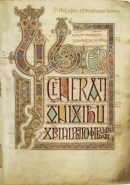| Genesis | Exodus | Leviticus | Numbers | Deuteronomy | Joshua | Judges | Ruth |
| 1 Samuel | 2 Samuel | 1 Kings | 2 Kings | 1 Chronicles | 2 Chronicles | Ezra |
| Nehemiah | Esther | Job | Psalms | Proverbs | Ecclesiastes | Song of Solomon |
| Isaiah | Jeremiah | Lamentations | Ezekiel | Daniel | Hosea | Joel | Amos | Obadiah |
| Jonah | Micah | Nahum | Habakkuk | Zephaniah | Haggai | Zechariah | Malachi |
| Tobit | Judith | Additions to Esther | Wisdom of Solomon | Ecclesiasticus | Baruch |
| Letter of Jeremiah | Prayer of Azariah | Susanna | Bel & the Dragon | 1 Maccabees |
| 2 Maccabees | 1 Esdras | 2 Esdras |
| Matthew | Mark | Luke | John | Acts | Romans | 1 Corinthians | 2 Corinthians |
| Galatians | Ephesians | Philippians | Colossians | 1 Thessalonians | 2 Thessalonians |
| 1 Timothy | 2 Timothy | Titus | Philemon | Hebrews | James | 1 Peter | 2 Peter |
| 1 John | 2 John | 3 John | Jude | Revelation |
 The Book:
The Book:
An additional six chapters appear interspersed in Esther in the Septuagint, the Greek translation, which then was used by Jerome in compiling the Latin Vulgate; additionally, the Greek text contains many small changes in the meaning of the main text. The extra chapters include several prayers to God, perhaps because it was felt that the above-mentioned lack of mention of God was inappropriate in a holy book. Jerome recognized them as later additions, placing them at the end of his work.
By the time Esther was written, the foreign power visible on the horizon as a future threat to Judah was the Macedonians of Alexander the Great, who defeated the Persian empire about 150 years after the time of the story of Esther; the Septuagint version noticeably calls Haman a Macedonian where the Hebrew text describes him as an Agagite.
The canonicity of these Greek additions has been a subject of scholarly disagreement practically since their first appearance in the Septuagint - Martin Luther, being perhaps the most vocal Reformation era critic of the work, considered even the original Hebrew version to be of very doubtful value. Luther's complaints against the book carried past the point of scholarly critique, and led in part to the complaint of anti-semitism frequently made against him. The Roman Catholic Council of Trent, the summation of the Roman Catholic Counter-Reformation, declared the entire book, both Hebrew text and Greek additions, to be canonical. While modern Roman Catholic scholars openly recognize the Greek additions as clearly being additions to the text, the Book of Esther is used twice in commonly used sections of the Catholic Lectionary. In both cases, the text used is not only taken from a Greek addition, the readings also are the prayer of Mordecai, and nothing of Esther's own words is ever used. The Eastern Orthodox Church uses the Septuagint version of Esther, as it does for all of the Old Testament.
Source: Wikipedia, the free encyclopedia © 2001-2006 Wikipedia contributors
(Disclaimer)
This article is licensed under the GNU Free Documentation Licence.
View this article at Wikipedia.org
 Print this page
Print this page